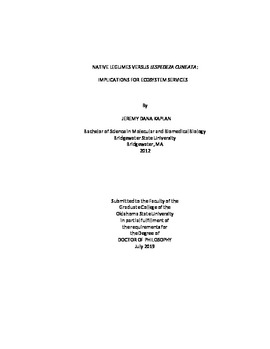| dc.contributor.advisor | Baum, Kristen A. | |
| dc.contributor.author | Kaplan, Jeremy Dana | |
| dc.date.accessioned | 2020-01-30T15:03:07Z | |
| dc.date.available | 2020-01-30T15:03:07Z | |
| dc.date.issued | 2019-07 | |
| dc.identifier.uri | https://hdl.handle.net/11244/323351 | |
| dc.description.abstract | Grasslands are the most threatened ecosystem worldwide due to habitat fragmentation and alteration, which have contributed to the spread of invasive plants. Fire is historically important in maintaining grasslands, and can reduce or eliminate some invasive plants, but facilitates the germination and spread of others. Invasive plants compete with natives and have the potential to impact ecosystem services (i.e., decomposition, soil C and N storage, pollination). Lespedeza cuneata is an invasive legume that reduces the abundance and diversity of native plants and can form monotypic stands. Many native legumes occur sympatrically with L. cuneata, including Lespedeza virginica and Baptisia bracteata. I evaluated if native versus invasive legume cover in different burn regimes influenced 1) litter decomposition and 2) invertebrate abundance and morphospecies richness, and if native versus invasive legume cover influenced 3) soil organic N (SON) and soil organic C (SOC), and 4) pollinator morphospecies richness and abundance. Sites were located within north-central Oklahoma in patch-burn managed rangelands. Findings suggest that decomposition and soil invertebrate morphospecies richness and abundance was highest in year of burn locations (versus two years since burn) and the highest level of L. cuneata cover. Decomposition was higher when microinvertebrates and macroinvertebrates were allowed access to litter, versus when only microinvertebrates were. SON and SOC (%) were positively correlated and lowest in areas with B. bracteata and increased as L. cuneata cover increased. Pollinator (Hymenoptera) richness was greater in locations with intermediate L. cuneata cover rather than in areas with more or less Lespedeza cover, including native Lespedeza cover. If abundance of decomposers and morphospecies richness of decomposers and pollinators is higher in locations dominated by L. cuneata, associated ecosystem services, including decomposition, soil C and N storage, and pollination, may contribute to its spread and the isolation of natives, further influencing grassland productivity and diversity. Additional research should evaluate these interactions with other invasive species and congeneric natives to identify factors that contribute to observed patterns across systems. | |
| dc.format | application/pdf | |
| dc.language | en_US | |
| dc.rights | Copyright is held by the author who has granted the Oklahoma State University Library the non-exclusive right to share this material in its institutional repository. Contact Digital Library Services at lib-dls@okstate.edu or 405-744-9161 for the permission policy on the use, reproduction or distribution of this material. | |
| dc.title | Native Legumes Versus Lespedeza cuneata: Implications for Ecosystem Services | |
| dc.contributor.committeeMember | Fuhlendorf, Samuel D. | |
| dc.contributor.committeeMember | Hickman, Karen R. | |
| dc.contributor.committeeMember | Wilson, Gail W. T. | |
| osu.filename | Kaplan_okstate_0664D_16427.pdf | |
| osu.accesstype | Open Access | |
| dc.type.genre | Dissertation | |
| dc.type.material | Text | |
| dc.subject.keywords | decomposition | |
| dc.subject.keywords | grassland | |
| dc.subject.keywords | invasive species | |
| dc.subject.keywords | invertebrate assemblages | |
| dc.subject.keywords | legume | |
| dc.subject.keywords | prescribed fire | |
| thesis.degree.discipline | Integrative Biology | |
| thesis.degree.grantor | Oklahoma State University | |
